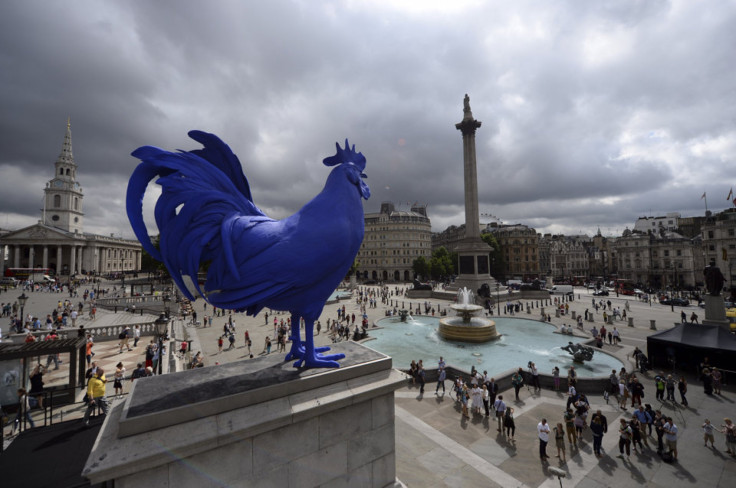Could A Big Blue Rooster In Trafalgar Square Spark Diplomatic Row Between Britain And France?

What is electric blue, 4.7 meters (15 feet) in height, and will remain for 18 months on a sculpture platform at Trafalgar Square, London? A giant ultramarine rooster!
On Thursday, London’s mayor, Boris Johnson, introduced to the public the latest piece of contemporary artwork joining the famous square, a large rooster called “Hahn/Cock” – "Hahn" meaning rooster in German – by the German artist Katharina Fritsch.
“Katharina Fritsch commands tremendous respect internationally, and her giant blue bird will provide a striking new focal as well as talking point for Londoners and tourists alike,” Johnson said during the unveiling ceremony.
But, if the mayor is rejoicing at the presence this new sculpture on the Fourth Plinth, others are more skeptical. Thorney Island Society, an organization created to protect London landmarks, said the indigo bird was “totally inappropriate” and “nothing but a feeble attraction.”
A major issue with the rooster lies with the fact that as Trafalgar Square is dominated by a statue of Admiral Lord Horatio Nelson -- who defeated the combined French and Spanish forces of Napoleon at Trafalgar in 1805 -- one of Britain's greatest military heroes. And the gallinaceous bird is French … or sort of. For centuries, the Gallic rooster has been one of the symbols of France stretching all the way back to antiquity during the reign of the Roman Empire.
To this day, the bird remains an important presence in the lives of the French -- for example, it was used as the mascot of the 1998 FIFA World Cup tournament and is part of brand names like Le Coq Sportif (which would literally translate as “the sportive rooster”).
“I’m sure if this gets planning permission, it will cause quite a stir, particularly because it will be placed under the gaze of Admiral Lord Nelson,” said Robert Davis, the deputy leader of the Westminster Council, to the London Evening Standard in May, when the rooster sculpture was first announced. “I do wonder what Nelson’s reaction would have been after returning home from battle only to be greeted by the French emblem standing proudly in the center of London.”
The Thorney Island Society decided to file a planning complaint. “We cannot see any logical reason for the proposed sculpture to be placed on the fourth plinth,” wrote the Society in the application. “It is unrelated to the context of Trafalgar Square.”
For many locals, having the bird staring at Admiral Nelson is tantamount to a diplomatic affront.
In addition, the German artist Fritsch used the color electric blue – although others argue that she actually used the International Klein Blue, created by the French artist Yves Klein. Moreover, the color blue just happens to be another symbol of France – but she claimed she never thought about “the French thing” in the first place, in an interview with The Guardian.
Indeed, she had another idea in mind with the sexual double entendre of the sculpture’s title.
“It’s about male posing, about showing power, about showing … erections! I mean, look at that column [Admiral Nelson’s column]!” she said to The Guardian.
Mayor Johnson spun his own take on the rooster's color. “It seems to be a very confident sort of bird,” he said. “I think that in some way it expresses something about our city and the general mood of confidence that I detect since the Olympics. It’s the correct color for a boy, which we’ve just had: We’ve just had a prince,” referring to the recent royal birth of Prince George.
The blue rooster will stay on the fourth plinth for the next year and a half. The plinth was supposed to support a statue of William IV of England on his horse, but it was never completed. For years now, the plinth now serves as a platform for the exhibition of contemporary artwork that is changed every 18 months.
As the rooster has not started a diplomatic incident yet, the British are going to have to do with the big blue bird. There is one advantage though … there is no chance of people being woken up early in the morning by the rooster's crowing.
© Copyright IBTimes 2025. All rights reserved.






















